How to grow Japanese maples in pots is a question that many gardening enthusiasts ask, and for good reason. These elegant trees, with their intricate foliage and graceful forms, add a touch of sophistication to any patio or balcony. But growing Japanese maples in containers requires a bit more attention than planting them in the ground.
The key to success lies in understanding their specific needs and providing the right environment for them to thrive.
This guide will walk you through every step of the process, from choosing the right variety and pot to ensuring proper watering, fertilizing, and overwintering care. We’ll cover everything you need to know to cultivate healthy and vibrant Japanese maples in pots, creating a stunning focal point in your outdoor space.
Choosing the Right Japanese Maple for a Pot
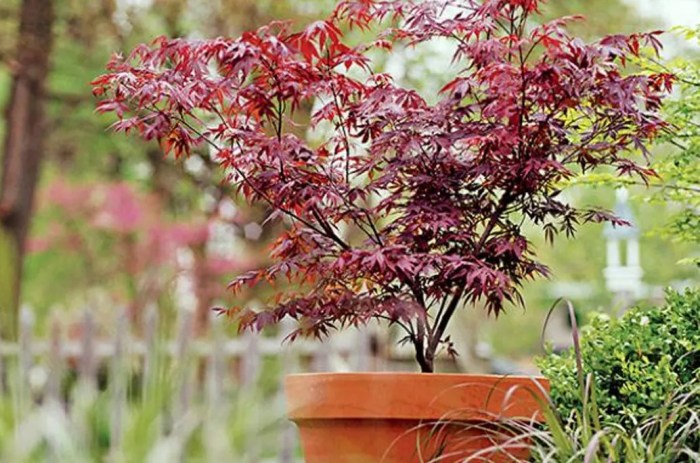
Not all Japanese maples are created equal when it comes to container growing. Some varieties are better suited to pots than others, and choosing the right one can make a big difference in the health and beauty of your tree.
Characteristics of Japanese Maples Suitable for Container Growing
When selecting a Japanese maple for a pot, consider the following characteristics:
- Size and Growth Habit:Choose varieties that stay relatively small and compact. Dwarf and weeping varieties are particularly well-suited for pots. These varieties tend to have a slower growth rate, making them easier to manage in containers.
- Root System:Japanese maples with shallow root systems are better adapted to container growing. Deep-rooted varieties may struggle in pots, as their roots can become overcrowded and stressed.
- Leaf Shape and Color:While leaf shape and color are primarily aesthetic preferences, certain varieties may be better suited for container growing. For example, varieties with smaller leaves tend to be more compact and may be easier to manage in pots.
Growth Habits of Different Varieties
Japanese maples come in a wide variety of growth habits, each with its own unique characteristics:
- Upright:Upright Japanese maples grow tall and narrow, with a central leader. These varieties are suitable for pots but may require more frequent pruning to maintain their shape.
- Weeping:Weeping Japanese maples have branches that cascade downwards, creating a graceful, weeping form. These varieties are often smaller in stature and are well-suited for pots.
- Dwarf:Dwarf Japanese maples remain small in size, making them ideal for container growing. They are often slow-growing and require minimal pruning.
Popular Japanese Maple Cultivars for Container Gardening
Here are some popular Japanese maple cultivars that are well-suited for container growing:
- ‘Crimson Queen’:This cultivar is known for its deep red foliage, which turns a vibrant crimson in the fall. It has a compact, weeping habit and grows to about 6 feet tall.
- ‘Bloodgood’:This variety has dark red foliage that turns a brilliant scarlet in the fall. It has an upright habit and grows to about 15 feet tall, making it suitable for larger containers.
- ‘Sango-kaku’:This cultivar is known for its striking coral-bark, which is particularly beautiful in winter. It has a graceful, weeping habit and grows to about 10 feet tall.
- ‘Dissectum’:This group of cultivars features finely dissected leaves, giving them a delicate, fern-like appearance. Many ‘Dissectum’ cultivars are compact and well-suited for pots.
- ‘Little Princess’:This dwarf variety grows to only 3 feet tall, making it ideal for small containers. It has a compact, upright habit and features delicate, green leaves that turn orange and red in the fall.
Preparing the Potting Mix
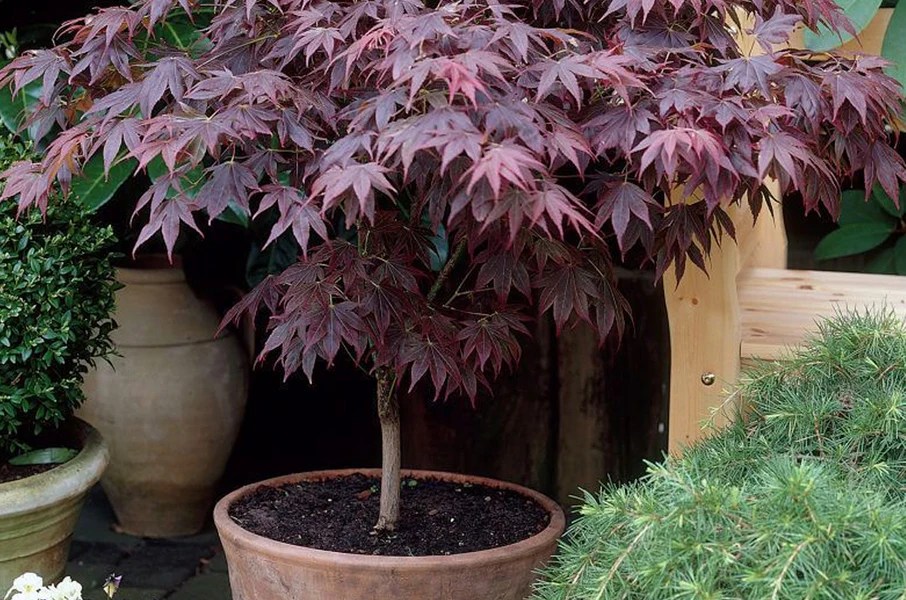
A well-draining potting mix is crucial for the health of your Japanese maple. These trees are susceptible to root rot if the soil is too wet, so it’s important to choose a mix that allows for good aeration and drainage.
Importance of Good Drainage and Aeration
A well-draining potting mix is essential for Japanese maples because it prevents the roots from sitting in waterlogged soil. This can lead to root rot, which can damage the tree and even kill it. Good aeration is also important for the roots, as it allows them to breathe and absorb nutrients properly.
Benefits of Organic Matter
Organic matter, such as compost or bark, provides several benefits to your Japanese maple’s potting mix:
- It improves drainage and aeration by creating air pockets in the soil.
- It helps retain moisture, which is important for the tree’s health.
- It provides nutrients to the tree, as it decomposes.
- It improves the soil’s structure, making it easier for roots to grow.
Potting Mix Recipe
Here’s a recipe for a well-draining potting mix for Japanese maples:
- 1 part peat moss:Peat moss is a good source of moisture and nutrients.
- 1 part coco coir:Coco coir is a sustainable alternative to peat moss and provides good drainage and aeration.
- 1 part compost:Compost provides nutrients and improves the soil’s structure.
- 1/2 part perlite or pumice:Perlite or pumice helps improve drainage and aeration.
You can adjust the proportions of the ingredients based on your specific climate and soil conditions.
Light and Temperature Requirements: How To Grow Japanese Maples In Pots
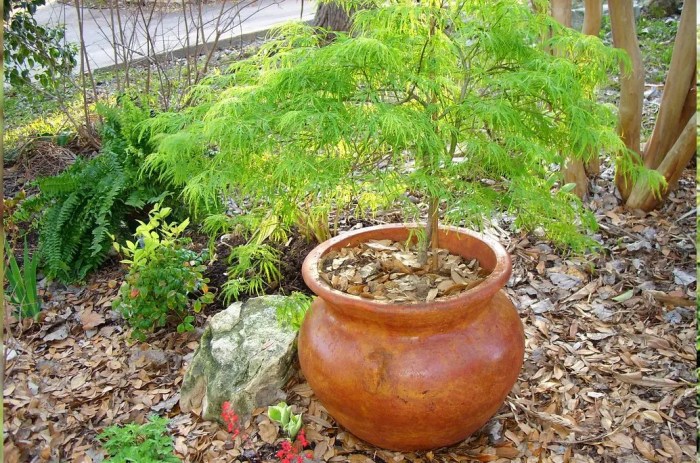
Japanese maples are known for their stunning foliage, which comes in a variety of colors and shapes. To maintain their vibrant colors and healthy growth, it’s essential to provide them with the right amount of light and temperature.
Light Requirements
Japanese maples thrive in dappled sunlight, which means they prefer a location that receives bright, indirect light for most of the day. Direct sunlight, especially during the hottest parts of the day, can scorch their leaves and lead to leaf burn.
- Ideal Light Conditions:Japanese maples in pots should be placed in a location that receives morning sun and afternoon shade. This ensures they get enough light for photosynthesis while avoiding the intense heat of the midday sun.
- Protecting from Direct Sunlight:If you live in a region with very hot summers, consider moving your potted Japanese maple to a shaded location during the hottest hours of the day. You can also use a shade cloth or umbrella to provide partial shade.
- Adjusting Location:Observe your tree throughout the day. If you notice signs of leaf burn, such as browning or scorching, move the pot to a more shaded location. Conversely, if the foliage appears dull or pale, consider moving it to a slightly brighter spot.
Watering and Fertilizing

Watering and fertilizing are crucial aspects of maintaining the health and vitality of your potted Japanese maple. Consistent moisture and proper nutrient supply are essential for optimal growth and development.
Growing Japanese maples in pots is a great way to enjoy their beauty even if you don’t have a large backyard. Just be sure to choose a pot that’s the right size for your tree and use a well-draining potting mix.
With a little care, you can enjoy the vibrant colors and elegant forms of these trees right on your patio or balcony.
Watering Needs
Japanese maples in pots require consistent moisture but are also susceptible to root rot if overwatered. The key is to maintain a balance between providing adequate water and avoiding waterlogged soil.
Determining When to Water
The best way to determine if your Japanese maple needs watering is to check the soil moisture. Stick your finger about 2 inches deep into the soil. If it feels dry, it’s time to water. You can also use a moisture meter for a more precise measurement.
Fertilizing for Healthy Growth, How to grow japanese maples in pots
Fertilizer plays a vital role in providing the necessary nutrients for your Japanese maple to thrive. It helps promote healthy growth, vibrant foliage, and strong roots. However, overfertilizing can damage the roots and lead to nutrient imbalances.
Fertilizer Application
Use a balanced fertilizer specifically formulated for acid-loving plants, such as azaleas and rhododendrons. Follow the instructions on the fertilizer package for the appropriate application rate and frequency. A slow-release fertilizer is generally preferred for potted Japanese maples, as it provides a consistent supply of nutrients over a longer period.
Pruning and Shaping
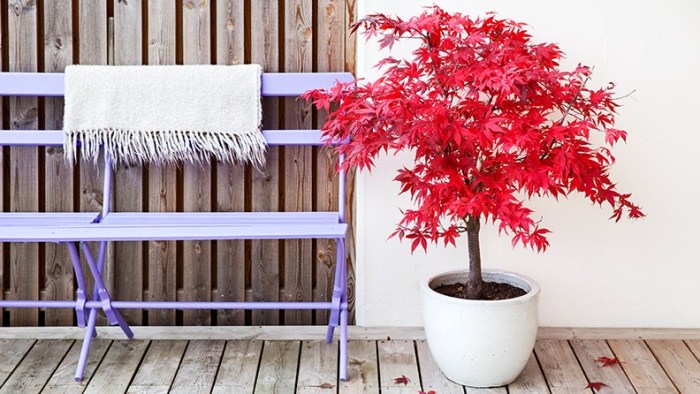
Pruning Japanese maples is an essential part of their care, not only for maintaining their shape and size but also for promoting their health. Regular pruning encourages new growth, prevents overcrowding, and helps to control the tree’s overall form.
Timing and Techniques
The best time to prune Japanese maples is in late winter or early spring, before new growth emerges. This is when the tree is dormant and less susceptible to disease. There are several different pruning techniques that can be used, each with its own purpose.
- Thinninginvolves removing entire branches back to their point of origin, which helps to improve air circulation and sunlight penetration.
- Heading backinvolves cutting back the tips of branches, which encourages bushier growth and helps to control the size of the tree.
- Selective pruninginvolves removing specific branches to shape the tree or remove damaged or diseased wood.
Shaping Techniques
Pruning can be used to create a variety of shapes and styles, depending on the desired aesthetic.
- Formal styles, such as the upright formal ( chokkan) or the informal upright ( moyogi), are characterized by a single central trunk and symmetrical branching.
- Informal styles, such as the cascade ( kengai) or the semi-cascade ( han-kengai), feature a more natural and flowing form.
- Informal stylescan also be used to create unique shapes, such as a weeping form or a rounded mound.
Protecting from Pests and Diseases
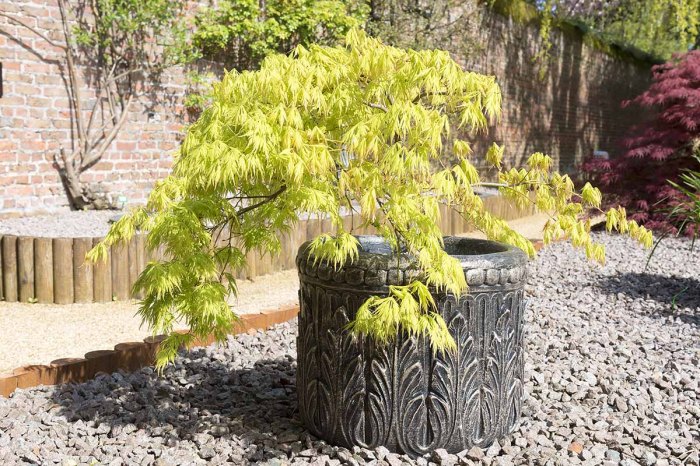
While Japanese maples are generally hardy trees, they can be susceptible to certain pests and diseases, especially when grown in pots. These issues can be exacerbated by the confined environment and the potential for stress due to inadequate care. However, by understanding the common threats and implementing preventive measures, you can keep your potted Japanese maple healthy and thriving.
Common Pests and Diseases
Identifying the pests and diseases that commonly affect Japanese maples is crucial for early detection and timely intervention.
- Aphids: These tiny, soft-bodied insects feed on plant sap, causing leaf distortion and discoloration. They can also transmit viruses.
- Scale: These armored insects attach themselves to stems and leaves, sucking sap and weakening the plant.
- Spider mites: These microscopic pests spin webs on the undersides of leaves and feed on plant sap, causing yellowing and browning.
- Leafhoppers: These insects feed on leaves, causing stippling and browning. They can also transmit diseases.
- Powdery mildew: This fungal disease appears as a white, powdery coating on leaves, which can eventually cause leaf drop.
- Root rot: This fungal disease occurs when the soil is constantly wet, causing root damage and eventual plant death.
- Verticillium wilt: This fungal disease infects the vascular system of the plant, causing wilting and leaf drop.
Overwintering Japanese Maples in Pots
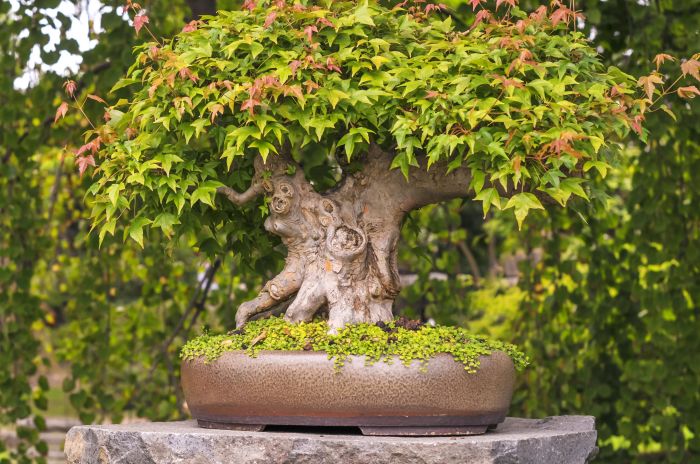
Overwintering Japanese maples in pots presents unique challenges due to their sensitivity to cold temperatures and the limited protection offered by containers. Unlike their counterparts planted in the ground, potted maples are more susceptible to frost damage, root damage, and dehydration during winter months.
Therefore, it’s crucial to implement proper strategies to ensure their survival and health through the cold season.
Protecting from Frost and Cold Temperatures
To protect Japanese maples from frost and cold temperatures, consider the following methods:
- Move the pot to a sheltered location:A south-facing wall or a covered porch can provide protection from harsh winds and cold temperatures. If possible, choose a location that receives some sunlight during the day to help maintain a warmer microclimate.
- Wrap the pot with insulation:Using burlap, bubble wrap, or even old blankets can help insulate the pot and protect the roots from freezing temperatures. Make sure to leave some space for air circulation to prevent moisture buildup.
- Create a snow blanket:If you live in a region with significant snowfall, allow snow to accumulate around the base of the pot. Snow acts as a natural insulator, helping to keep the soil temperature stable.
Providing Adequate Insulation and Moisture
Adequate insulation and moisture are crucial for overwintering Japanese maples in pots.
- Mulch the soil:A layer of organic mulch, such as pine needles or shredded bark, can help insulate the soil and prevent it from freezing. This will also help retain moisture and prevent the soil from drying out.
- Water deeply but infrequently:During winter, the soil will freeze, reducing the rate of water absorption by the roots. Water deeply but infrequently to ensure the soil is adequately moist but not waterlogged.
- Monitor soil moisture:Regularly check the soil moisture by inserting your finger into the soil. If the soil feels dry, water the tree deeply.
Repotting Japanese Maples
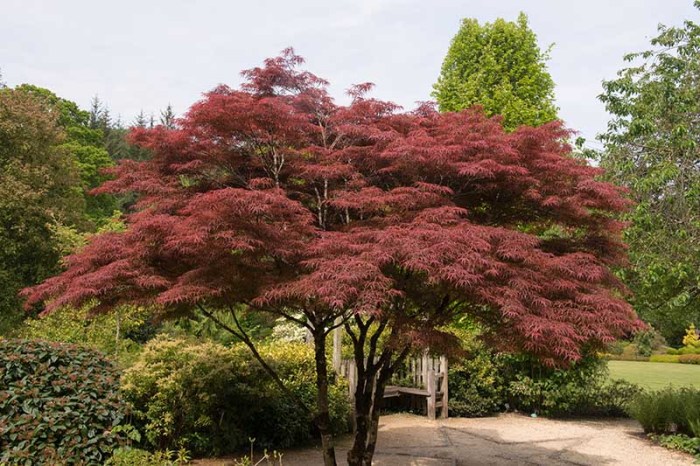
Repotting your Japanese maple is an essential part of its care, especially as it grows and its root system expands. This process allows you to refresh the potting mix, check for root health, and ensure the tree has adequate space to thrive.
Repotting is typically done every few years, depending on the tree’s growth rate and the size of the pot.
Choosing the Right Pot Size
Selecting the appropriate pot size for repotting is crucial for the Japanese maple’s well-being. A pot that is too small will restrict root growth and lead to stunted development, while a pot that is too large can increase the risk of overwatering and root rot.When choosing a pot size, consider the following:
- Current pot size:The new pot should be slightly larger than the current one, typically 2-4 inches wider in diameter.
- Tree’s size:The pot should be proportional to the tree’s size. A small tree will need a smaller pot, while a larger tree will require a larger pot.
- Tree’s growth rate:Fast-growing Japanese maples will need to be repotted more frequently than slow-growing varieties.
Repotting a Japanese Maple
Repotting a Japanese maple is a straightforward process, but it’s important to follow the correct steps to minimize stress on the tree.
- Prepare the new pot:Choose a pot with drainage holes and place a layer of gravel or broken pottery shards at the bottom for drainage.
- Remove the tree from its current pot:Gently tap the bottom of the pot to loosen the tree. If it doesn’t come out easily, you can use a tool like a trowel to help loosen the edges.
- Inspect the roots:Examine the root system for any signs of damage or disease. If you find any, trim them away with clean, sharp pruning shears.
- Add potting mix:Fill the new pot with fresh potting mix, leaving about an inch of space at the top. Place the tree in the pot, ensuring the root ball is level with the top of the pot.
- Backfill with potting mix:Gently fill in around the root ball with more potting mix, making sure to avoid compacting the soil.
- Water thoroughly:After repotting, water the tree deeply to settle the potting mix and ensure the roots are well-hydrated.
- Place in a shady location:For the first few weeks after repotting, place the Japanese maple in a shady location to help it adjust to its new pot.
Ultimate Conclusion
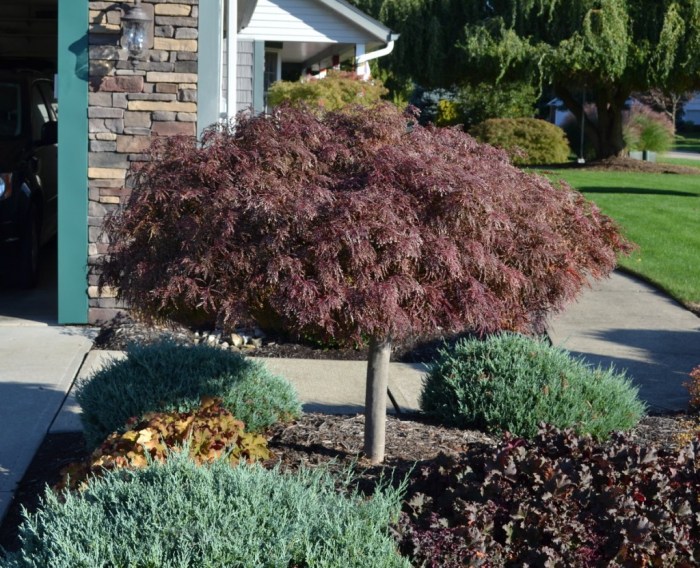
Growing Japanese maples in pots is a rewarding experience that allows you to enjoy the beauty of these trees even in limited spaces. By following the tips and techniques Artikeld in this guide, you can cultivate stunning specimens that will bring joy and tranquility to your home for years to come.
Remember, the journey of growing a Japanese maple is an ongoing one, so embrace the process, learn from your experiences, and enjoy the beauty that these remarkable trees bring to your life.